Frank Rudzicz
Exploring the features used for summary evaluation by Human and GPT
Dec 22, 2025Abstract:Summary assessment involves evaluating how well a generated summary reflects the key ideas and meaning of the source text, requiring a deep understanding of the content. Large Language Models (LLMs) have been used to automate this process, acting as judges to evaluate summaries with respect to the original text. While previous research investigated the alignment between LLMs and Human responses, it is not yet well understood what properties or features are exploited by them when asked to evaluate based on a particular quality dimension, and there has not been much attention towards mapping between evaluation scores and metrics. In this paper, we address this issue and discover features aligned with Human and Generative Pre-trained Transformers (GPTs) responses by studying statistical and machine learning metrics. Furthermore, we show that instructing GPTs to employ metrics used by Human can improve their judgment and conforming them better with human responses.
When Can We Trust LLMs in Mental Health? Large-Scale Benchmarks for Reliable LLM Evaluation
Oct 21, 2025Abstract:Evaluating Large Language Models (LLMs) for mental health support is challenging due to the emotionally and cognitively complex nature of therapeutic dialogue. Existing benchmarks are limited in scale, reliability, often relying on synthetic or social media data, and lack frameworks to assess when automated judges can be trusted. To address the need for large-scale dialogue datasets and judge reliability assessment, we introduce two benchmarks that provide a framework for generation and evaluation. MentalBench-100k consolidates 10,000 one-turn conversations from three real scenarios datasets, each paired with nine LLM-generated responses, yielding 100,000 response pairs. MentalAlign-70k}reframes evaluation by comparing four high-performing LLM judges with human experts across 70,000 ratings on seven attributes, grouped into Cognitive Support Score (CSS) and Affective Resonance Score (ARS). We then employ the Affective Cognitive Agreement Framework, a statistical methodology using intraclass correlation coefficients (ICC) with confidence intervals to quantify agreement, consistency, and bias between LLM judges and human experts. Our analysis reveals systematic inflation by LLM judges, strong reliability for cognitive attributes such as guidance and informativeness, reduced precision for empathy, and some unreliability in safety and relevance. Our contributions establish new methodological and empirical foundations for reliable, large-scale evaluation of LLMs in mental health. We release the benchmarks and codes at: https://github.com/abeerbadawi/MentalBench/
SoftAdaClip: A Smooth Clipping Strategy for Fair and Private Model Training
Oct 01, 2025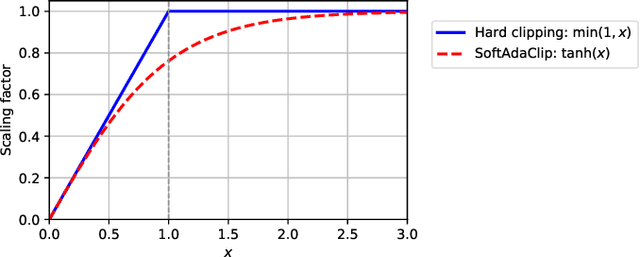
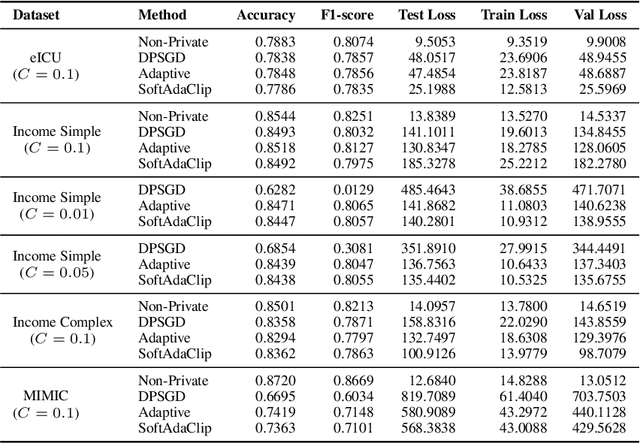


Abstract:Differential privacy (DP) provides strong protection for sensitive data, but often reduces model performance and fairness, especially for underrepresented groups. One major reason is gradient clipping in DP-SGD, which can disproportionately suppress learning signals for minority subpopulations. Although adaptive clipping can enhance utility, it still relies on uniform hard clipping, which may restrict fairness. To address this, we introduce SoftAdaClip, a differentially private training method that replaces hard clipping with a smooth, tanh-based transformation to preserve relative gradient magnitudes while bounding sensitivity. We evaluate SoftAdaClip on various datasets, including MIMIC-III (clinical text), GOSSIS-eICU (structured healthcare), and Adult Income (tabular data). Our results show that SoftAdaClip reduces subgroup disparities by up to 87% compared to DP-SGD and up to 48% compared to Adaptive-DPSGD, and these reductions in subgroup disparities are statistically significant. These findings underscore the importance of integrating smooth transformations with adaptive mechanisms to achieve fair and private model training.
Contrastive Similarity Learning for Market Forecasting: The ContraSim Framework
Feb 22, 2025



Abstract:We introduce the Contrastive Similarity Space Embedding Algorithm (ContraSim), a novel framework for uncovering the global semantic relationships between daily financial headlines and market movements. ContraSim operates in two key stages: (I) Weighted Headline Augmentation, which generates augmented financial headlines along with a semantic fine-grained similarity score, and (II) Weighted Self-Supervised Contrastive Learning (WSSCL), an extended version of classical self-supervised contrastive learning that uses the similarity metric to create a refined weighted embedding space. This embedding space clusters semantically similar headlines together, facilitating deeper market insights. Empirical results demonstrate that integrating ContraSim features into financial forecasting tasks improves classification accuracy from WSJ headlines by 7%. Moreover, leveraging an information density analysis, we find that the similarity spaces constructed by ContraSim intrinsically cluster days with homogeneous market movement directions, indicating that ContraSim captures market dynamics independent of ground truth labels. Additionally, ContraSim enables the identification of historical news days that closely resemble the headlines of the current day, providing analysts with actionable insights to predict market trends by referencing analogous past events.
Can large language models be privacy preserving and fair medical coders?
Dec 07, 2024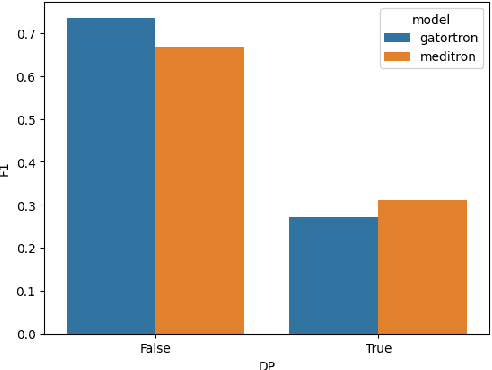
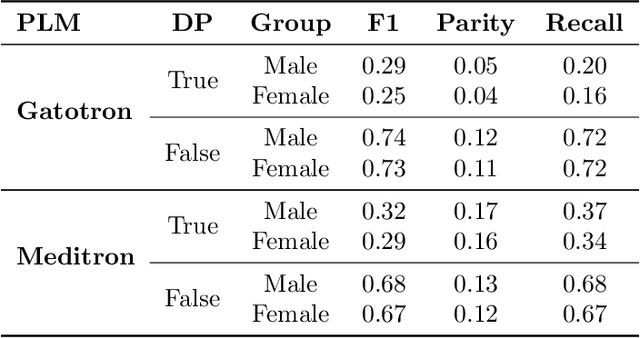
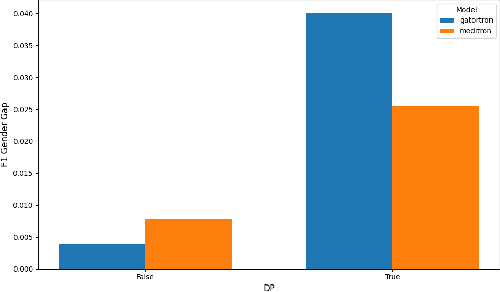
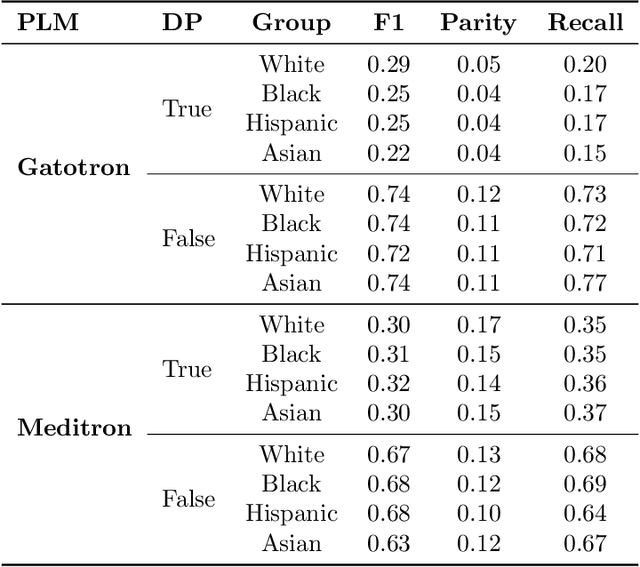
Abstract:Protecting patient data privacy is a critical concern when deploying machine learning algorithms in healthcare. Differential privacy (DP) is a common method for preserving privacy in such settings and, in this work, we examine two key trade-offs in applying DP to the NLP task of medical coding (ICD classification). Regarding the privacy-utility trade-off, we observe a significant performance drop in the privacy preserving models, with more than a 40% reduction in micro F1 scores on the top 50 labels in the MIMIC-III dataset. From the perspective of the privacy-fairness trade-off, we also observe an increase of over 3% in the recall gap between male and female patients in the DP models. Further understanding these trade-offs will help towards the challenges of real-world deployment.
Show, Don't Tell: Uncovering Implicit Character Portrayal using LLMs
Dec 05, 2024



Abstract:Tools for analyzing character portrayal in fiction are valuable for writers and literary scholars in developing and interpreting compelling stories. Existing tools, such as visualization tools for analyzing fictional characters, primarily rely on explicit textual indicators of character attributes. However, portrayal is often implicit, revealed through actions and behaviors rather than explicit statements. We address this gap by leveraging large language models (LLMs) to uncover implicit character portrayals. We start by generating a dataset for this task with greater cross-topic similarity, lexical diversity, and narrative lengths than existing narrative text corpora such as TinyStories and WritingPrompts. We then introduce LIIPA (LLMs for Inferring Implicit Portrayal for Character Analysis), a framework for prompting LLMs to uncover character portrayals. LIIPA can be configured to use various types of intermediate computation (character attribute word lists, chain-of-thought) to infer how fictional characters are portrayed in the source text. We find that LIIPA outperforms existing approaches, and is more robust to increasing character counts (number of unique persons depicted) due to its ability to utilize full narrative context. Lastly, we investigate the sensitivity of portrayal estimates to character demographics, identifying a fairness-accuracy tradeoff among methods in our LIIPA framework -- a phenomenon familiar within the algorithmic fairness literature. Despite this tradeoff, all LIIPA variants consistently outperform non-LLM baselines in both fairness and accuracy. Our work demonstrates the potential benefits of using LLMs to analyze complex characters and to better understand how implicit portrayal biases may manifest in narrative texts.
Library Learning Doesn't: The Curious Case of the Single-Use "Library"
Oct 26, 2024


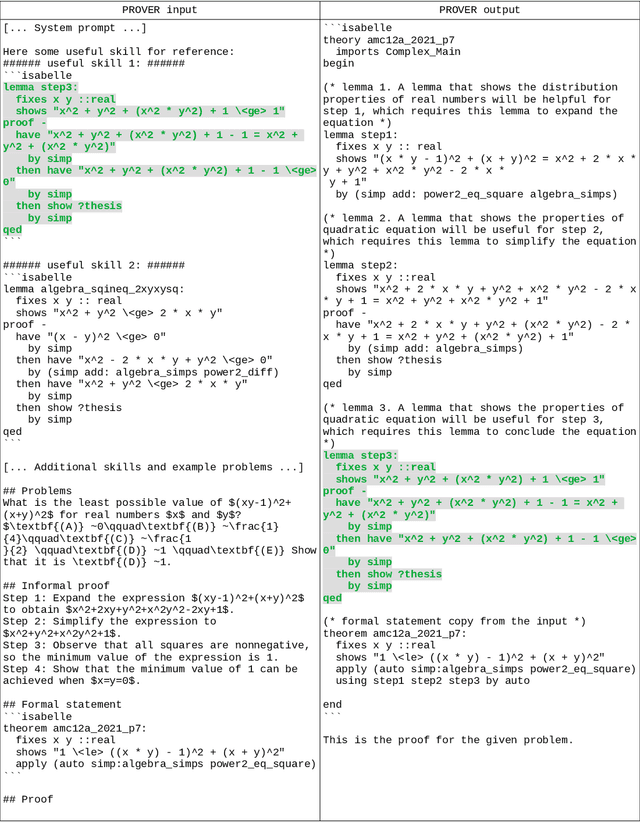
Abstract:Advances in Large Language Models (LLMs) have spurred a wave of LLM library learning systems for mathematical reasoning. These systems aim to learn a reusable library of tools, such as formal Isabelle lemmas or Python programs that are tailored to a family of tasks. Many of these systems are inspired by the human structuring of knowledge into reusable and extendable concepts, but do current methods actually learn reusable libraries of tools? We study two library learning systems for mathematics which both reported increased accuracy: LEGO-Prover and TroVE. We find that function reuse is extremely infrequent on miniF2F and MATH. Our followup ablation experiments suggest that, rather than reuse, self-correction and self-consistency are the primary drivers of the observed performance gains. Our code and data are available at https://github.com/ikb-a/curious-case
Graph-tree Fusion Model with Bidirectional Information Propagation for Long Document Classification
Oct 03, 2024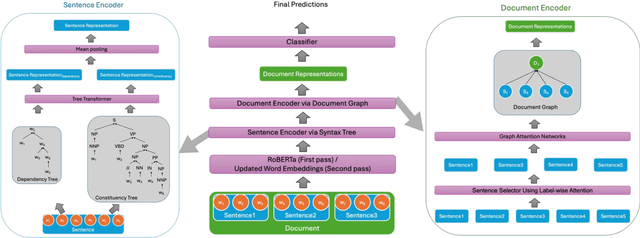
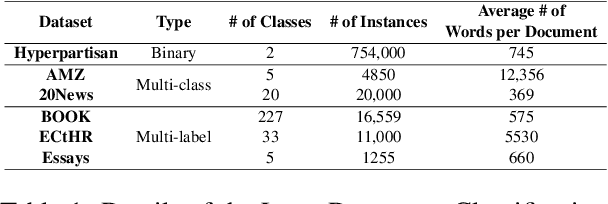
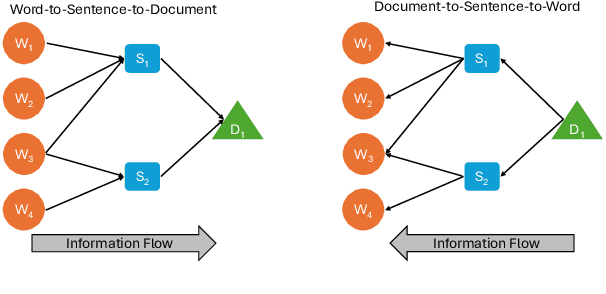

Abstract:Long document classification presents challenges in capturing both local and global dependencies due to their extensive content and complex structure. Existing methods often struggle with token limits and fail to adequately model hierarchical relationships within documents. To address these constraints, we propose a novel model leveraging a graph-tree structure. Our approach integrates syntax trees for sentence encodings and document graphs for document encodings, which capture fine-grained syntactic relationships and broader document contexts, respectively. We use Tree Transformers to generate sentence encodings, while a graph attention network models inter- and intra-sentence dependencies. During training, we implement bidirectional information propagation from word-to-sentence-to-document and vice versa, which enriches the contextual representation. Our proposed method enables a comprehensive understanding of content at all hierarchical levels and effectively handles arbitrarily long contexts without token limit constraints. Experimental results demonstrate the effectiveness of our approach in all types of long document classification tasks.
Self-Supervised Embeddings for Detecting Individual Symptoms of Depression
Jun 25, 2024



Abstract:Depression, a prevalent mental health disorder impacting millions globally, demands reliable assessment systems. Unlike previous studies that focus solely on either detecting depression or predicting its severity, our work identifies individual symptoms of depression while also predicting its severity using speech input. We leverage self-supervised learning (SSL)-based speech models to better utilize the small-sized datasets that are frequently encountered in this task. Our study demonstrates notable performance improvements by utilizing SSL embeddings compared to conventional speech features. We compare various types of SSL pretrained models to elucidate the type of speech information (semantic, speaker, or prosodic) that contributes the most in identifying different symptoms. Additionally, we evaluate the impact of combining multiple SSL embeddings on performance. Furthermore, we show the significance of multi-task learning for identifying depressive symptoms effectively.
How Well Can Knowledge Edit Methods Edit Perplexing Knowledge?
Jun 25, 2024Abstract:As large language models (LLMs) are widely deployed, targeted editing of their knowledge has become a critical challenge. Recently, advancements in model editing techniques, such as Rank-One Model Editing (ROME), have paved the way for updating LLMs with new knowledge. However, the efficacy of these methods varies across different types of knowledge. This study investigates the capability of knowledge editing methods to incorporate new knowledge with varying degrees of "perplexingness", a term we use to describe the initial difficulty LLMs have in understanding new concepts. We begin by quantifying the "perplexingness" of target knowledge using pre-edit conditional probabilities, and assess the efficacy of edits through post-edit conditional probabilities. Utilizing the widely-used CounterFact dataset, we find significant negative correlations between the "perplexingness" of the new knowledge and the edit efficacy across all 12 scenarios. To dive deeper into this phenomenon, we introduce a novel dataset, HierarchyData, consisting of 99 hyponym-hypernym pairs across diverse categories. Our analysis reveal that more abstract concepts (hypernyms) tend to be more perplexing than their specific counterparts (hyponyms). Further exploration into the influence of knowledge hierarchy on editing outcomes indicates that knowledge positioned at higher hierarchical levels is more challenging to modify in some scenarios. Our research highlights a previously overlooked aspect of LLM editing: the variable efficacy of editing methods in handling perplexing knowledge. By revealing how hierarchical relationships can influence editing outcomes, our findings offer new insights into the challenges of updating LLMs and pave the way for more nuanced approaches to model editing in the future.
 Add to Chrome
Add to Chrome Add to Firefox
Add to Firefox Add to Edge
Add to Edge